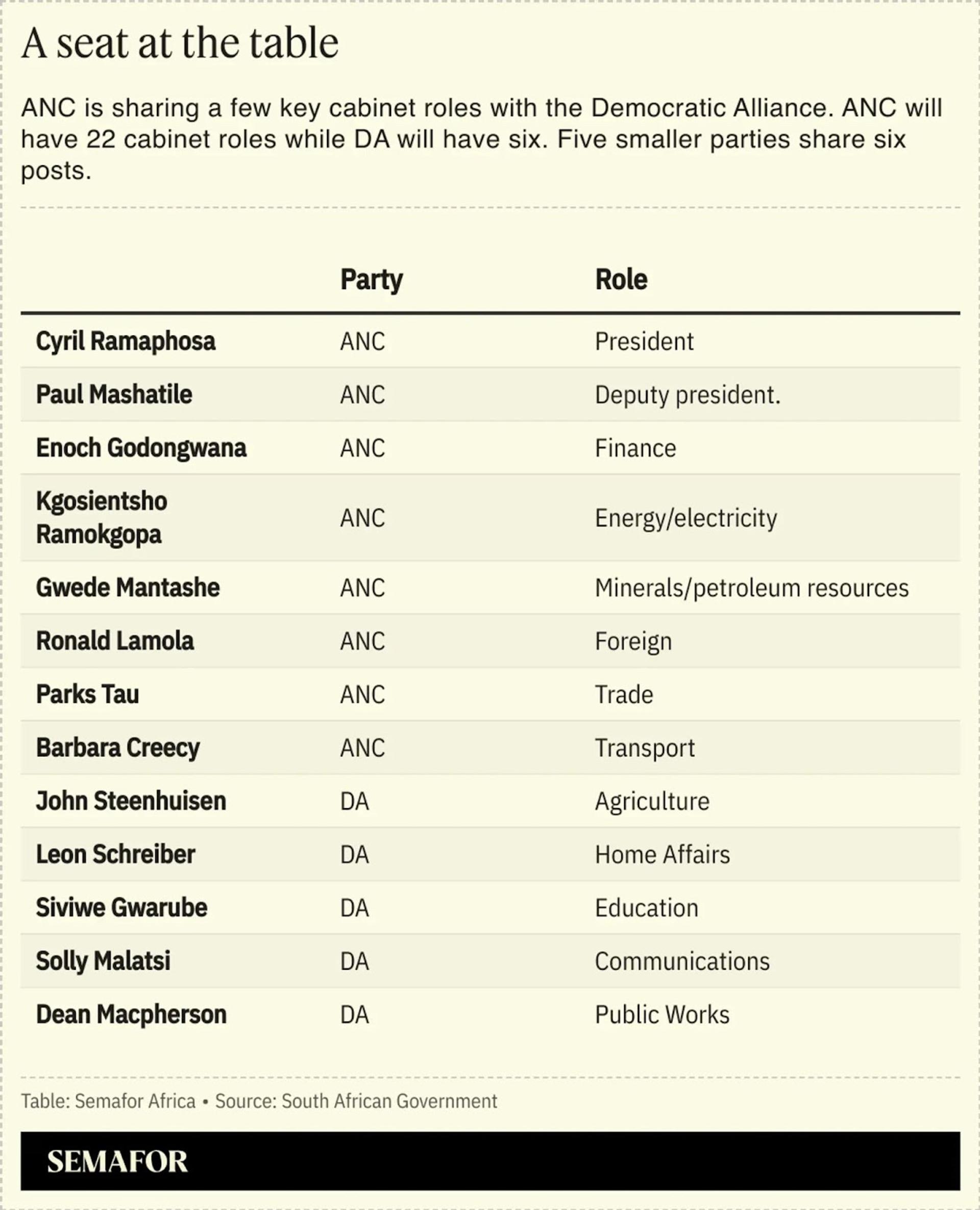The Scene
CAPE TOWN — John Steenhuisen enjoys shooting clay pigeons to relax away from the hurly-burly of South African politics. He will need to put his target-shooting skills to good use, as he aims to make impact fast, in a whole new arrangement of South African politics.
Steenhuisen, 48, has emerged as one of South Africa’s most prominent politicians. On Monday, he led the opposition Democratic Alliance into what was previously unthinkable in South Africa’s intensely-racialized politics: a coalition cabinet with the African National Congress.
President Cyril Ramaphosa made him agriculture minister and appointed five of Steenhuisen’s colleagues to the 32-member cabinet which was due to be sworn in on Tuesday.
“It’s a big moment for the DA and the country, I think that it is a massively different path for where we’re heading,” Steenhuisen told Semafor Africa in an interview.
In this article:
Step Back
Agriculture provides new terrain for the career-politician who sold pharmaceutical goods in his first job after leaving school in the coastal town of Durban.
He said agriculture is a ministry from which he can make an impact. “If you look at other countries who have been in a similar situation to South Africa, we have a large, unemployed unskilled population, that agriculture and agro processing has been the catalyst that has been able to allow those nations to progress.”
Steenhuisen said he was “very excited” about the opportunities around agriculture and agri processing to “grow the sector to create jobs and to contribute towards repairing the South African economy.”
Steenhuisen was at the center of a tough negotiation process following the May 29 elections, in which the ANC lost its majority for the first time since Nelson Mandela led it to power in 1994. In talks that were at times fraught — so much so that negotiations stalled briefly over the number of ministers the DA would have in the cabinet. Ramaphosa, in a letter to Steenhuisen last week, even accused Steenhuisen’s party of attempting to create a “parallel government.”
Sam’s view
Many DA leaders before Steenhuisen have dreamt of attaining state power. Given the country’s history of apartheid and the view of many South Africans that the DA represents the interests of a white minority who make up only 7% of the country, it looked unlikely to become a reality.
The DA’s elevation to government may provoke envy in Steenhuisen’s colleagues, a year before the party holds leadership elections. A few missteps on his part may make him vulnerable to internal criticisms before the DA election next year. He can also use the government to soar and bulletproof himself against an internal challenge.
The DA’s leader has earned a reputation as a pugnacious chief whip in parliament from 2014, a role he held for five years. He brings a no frills approach to politics, far from the messianic fervor his predecessor Mmusi Maimane attempted to inject into the DA’s offerings. In its place is a list of political priorities, shorn of grandiose ideological flourishes, that make up a “commonsense”-type approach.
Steenhuisen’s summaries of the DA’s positions, which he set out to me in an interview earlier this year, are the legacy of these earlier attempts to frame a plausible liberal-inspired narrative in a society that, by some important measures, doesn’t obviously lend itself to multiparty democracy. One of these features is inequality which, with mass unemployment and poverty, leaves millions without a stake in the market-dominated economy the DA proposes. Combined with a surge in lawlessness and gangsterism, the political center may be holding — but only just.
Know More

Those close to the DA leader paint a picture of a determined man who revels in his hobbies to relax.
Geordin Hill-Lewis, the mayor of Cape Town and a long-term DA colleague, says Steenhuisen is one of the most intelligent politicians he knows and his natural instincts are an asset.”
One of those moments was the choice to lead the agriculture ministry when power-sharing with the ANC was discussed.
“I often mock him about his history as a baby products salesman. He sold nappies, baby cream, and baby powder among others,” said Hill-Lewis. But he says Steenhuisen had visceral political instincts that put him above most opponents.
Steenhuisen dropped out of university, where he was studying politics and political leaders. “I sort of got caught up working and sort of trying to balance getting married and then working full time and started a family,” he said in the interview with Semafor Africa. “I just didn’t finish and it’s one of the big regrets I have in life and I intend to go back and finish.” That he dropped out often invites ridicule from his opponents, who claim he is not knowledgeable enough.
Steenhuisen’s critics say he is short-tempered and will likely find it hard to operate in a coalition cabinet where persuasion and debate will be crucial elements. But others, like Nelson Mandela University politics lecturer Ongama Mtimka, disagree.
“At face value, John has the demeanor of someone who would bring combative politics in cabinet and also be amenable to working in a team,” said Mtimka. “He will have to manage the complex new realities of transitioning from an opposition leader to a part of a government with people he has seen as opponents before, without dropping any of the balls he is juggling.”
Notable
- Ramaphosa split what was previously one ministry for the coalition government. While the DA took agriculture, the ANC retained land reform and rural development. The move recognizes that calls by ANC off-shoots, such as the Economic Freedom Fighters, to redistribute land ownership resonate with voters.
